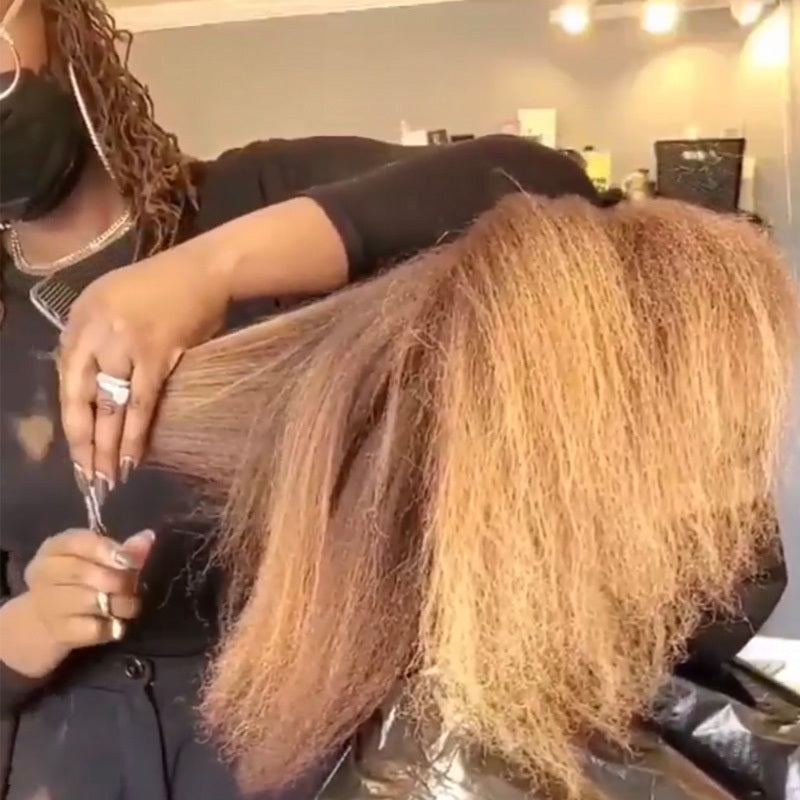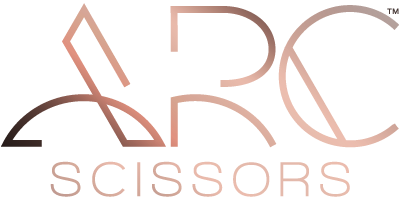6 Tips To Cut Textured Hair Like A Pro

Curly Cutting Guide: When to Cut Wet vs. Dry, How To Navigate Shrinkage & When To Use Tension
Do you want to get more comfortable cutting textured hair? Kara Williams (@haircolorkilla) shares six pro tips on some of the most asked questions when cutting curly and wavy hair. Learn the tricks for wet vs. dry cuts, how to adjust the proper amounts of tension and more!

Instagram via @haircolorkilla
CLICK HERE TO GET 30% OFF ALL ARC SCISSORS! BLACK FRIDAY SALE HAPPENING NOW

#1: Should I wash and blow-dry before every cut?
Depending on how your client plans to wear their hair after a haircut will determine if you cut wet or dry. Kara explains when her clients want to have the versatility to style their hair after a cut (ex: twist outs, rod sets, straight styles), she prefers to work on blow-dried hair.
Washing and blow drying is a way to pre-stretch the hair, leaving enough volume to visualize how the hair will lay when worn curly, allowing for a clear guide to cut for when hair is worn straight.
Pro Tip: You need extremely sharp scissors to cut textured hair evenly. To prevent jagged ends that don't blend throughout a cut, Kara uses ARC Scissors™ PARAGON II. The blades on the PARAGON II are strong enough to cut through curls and coils, avoiding uneven (and damaged!) ends from blades tugging on the hair.
Kara's go-to scissors for cutting texture:

ARC SCISSORS™ PARAGON II
Get 15% OFF—Use code ARC15
#2: Does shrinkage affect the way you cut textured hair?
Shrinkage plays a major part in determining how to approach any textured haircut. During a consultation, Kara makes sure to determine how much the client’s hair shrinks when dry. She suggests asking for clients’ selfies to help find out how their hair looks when completely dry and styled!
Pro Tip: If you're working on a new client, it may be best to wash and blow-dry the hair before cutting. Doing this will allow you to see the hair wet, assessing how their natural pattern lays before and after shrinkage to determine any length you may need to leave to achieve a desired cut.


#3: How to determine when to cut textured hair wet or dry
Here are a few important things to consider before deciding to cut any wavy or curly client wet or dry.
- Curly hair has the ability to shrink up to 50% of its length when dry
- Textured hair lays very differently wet vs dry
- Detailing textured hair (ex: adding layers)
That being said, here’s when to cut wet vs. dry!
Cut Wet If The Client:
- Has a wavy natural texture
- Has low-shrinkage
- Wears a style with a lot of movement
Cut Dry If The Client:
- Has very curly hair
- Has a lot of shrinkage
- Wears their natural texture often
#4: What’s best: cutting with or without tension?
Remember there’s no one-size-fits-all way to cut textured hair. During the consultation, you must take into account a client’s everyday lifestyle and desired goals to decide what cutting method is best. Here’s how Kara assesses whether or not to use tension.
The ideal client for cutting with tension (stretching hair out of its natural curl pattern):
- Clients who occasionally straighten or wear their hair stretched out of its natural curl pattern. This will allow the ends to be cut enough to remove any length desired while leaving room for different styles to be worn seamlessly.
The ideal client for cutting WITHOUT tension:
- Rarely (or never) applies heat to their hair. Clients who always wear their natural texture should always be cut without tension to avoid the hair being cut too short and laying unevenly.
#5: Should you cut or color first, why?
A lot of clients want their hair cut and colored during the same appointment. This works to a stylist's advantage because we're able to tailor a color with the haircut and vice versa. Kara recommends always cutting first for a few key reasons!
Reason #1: Avoid Throwing Away Product
Textured hair often has higher density, so it can absorb a lot of product. Cutting the hair first will avoid wasting product so you are not coloring hair that will be on the floor shortly after.
Reason #2: Establishing Shape First
With popular color trends like gradients or blended blonding techniques—it’s key to create a haircut's shape first, so you have a guide to follow when painting. A great haircut can help determine color placement for trendy requests like money pieces depending if the client is looking for bangs or not.
#6: How do you schedule and price haircuts?
Cutting textured hair doesn’t take any longer than a regular haircut, says Kara. She typically schedules about 45 minutes for the haircut and blow-dry, but also prices styling services separately. This way, it’s easier to give the client a more accurate time frame by splitting services up and offering different styling options.
Pricing Specialty vs. Non-Specialty Cuts
- Specialty haircuts: Cutting one curl at a time: This type of cut requires additional education and is not accessible at every hair salon. Using ARC™ Scissors Paragon II for speciality cuts is ideal to move through textured hair for a seamless blend (even through curls and coils)! Make sure to charge appropriately for your education, quality tools used and expanded service menu.
- Non-specialty cuts: If you’re doing a regular haircut, clients with curly and textured hair should not have to pay more. “Hair is hair, and as stylists, we want to be able to offer services to our customers with all textures,” says Kara. Haircut pricing for straight, wavy, curly and textured hair should be the same as any other cut on your service menu.
CLICK HERE TO GET 30% OFF ALL ARC SCISSORS! BLACK FRIDAY SALE HAPPENING NOW

#1: Should I wash and blow-dry before every cut?
Depending on how your client plans to wear their hair after a haircut will determine if you cut wet or dry. Kara explains when her clients want to have the versatility to style their hair after a cut (ex: twist outs, rod sets, straight styles), she prefers to work on blow-dried hair.
Washing and blow drying is a way to pre-stretch the hair, leaving enough volume to visualize how the hair will lay when worn curly, allowing for a clear guide to cut for when hair is worn straight.
Pro Tip: You need extremely sharp scissors to cut textured hair evenly. To prevent jagged ends that don't blend throughout a cut, Kara uses ARC Scissors™ PARAGON II. The blades on the PARAGON II are strong enough to cut through curls and coils, avoiding uneven (and damaged!) ends from blades tugging on the hair.
Kara's go-to scissors for cutting texture:

ARC SCISSORS™ PARAGON II
Get 15% OFF—Use code ARC15
#2: Does shrinkage affect the way you cut textured hair?
Shrinkage plays a major part in determining how to approach any textured haircut. During a consultation, Kara makes sure to determine how much the client’s hair shrinks when dry. She suggests asking for clients’ selfies to help find out how their hair looks when completely dry and styled!
Pro Tip: If you're working on a new client, it may be best to wash and blow-dry the hair before cutting. Doing this will allow you to see the hair wet, assessing how their natural pattern lays before and after shrinkage to determine any length you may need to leave to achieve a desired cut.


#3: How to determine when to cut textured hair wet or dry
Here are a few important things to consider before deciding to cut any wavy or curly client wet or dry.
- Curly hair has the ability to shrink up to 50% of its length when dry
- Textured hair lays very differently wet vs dry
- Detailing textured hair (ex: adding layers)
That being said, here’s when to cut wet vs. dry!
Cut Wet If The Client:
- Has a wavy natural texture
- Has low-shrinkage
- Wears a style with a lot of movement
Cut Dry If The Client:
- Has very curly hair
- Has a lot of shrinkage
- Wears their natural texture often
#4: What’s best: cutting with or without tension?
Remember there’s no one-size-fits-all way to cut textured hair. During the consultation, you must take into account a client’s everyday lifestyle and desired goals to decide what cutting method is best. Here’s how Kara assesses whether or not to use tension.
The ideal client for cutting with tension (stretching hair out of its natural curl pattern):
- Clients who occasionally straighten or wear their hair stretched out of its natural curl pattern. This will allow the ends to be cut enough to remove any length desired while leaving room for different styles to be worn seamlessly.
The ideal client for cutting WITHOUT tension:
- Rarely (or never) applies heat to their hair. Clients who always wear their natural texture should always be cut without tension to avoid the hair being cut too short and laying unevenly.
#5: Should you cut or color first, why?
A lot of clients want their hair cut and colored during the same appointment. This works to a stylist's advantage because we're able to tailor a color with the haircut and vice versa. Kara recommends always cutting first for a few key reasons!
Reason #1: Avoid Throwing Away Product
Textured hair often has higher density, so it can absorb a lot of product. Cutting the hair first will avoid wasting product so you are not coloring hair that will be on the floor shortly after.
Reason #2: Establishing Shape First
With popular color trends like gradients or blended blonding techniques—it’s key to create a haircut's shape first, so you have a guide to follow when painting. A great haircut can help determine color placement for trendy requests like money pieces depending if the client is looking for bangs or not.
#6: How do you schedule and price haircuts?
Cutting textured hair doesn’t take any longer than a regular haircut, says Kara. She typically schedules about 45 minutes for the haircut and blow-dry, but also prices styling services separately. This way, it’s easier to give the client a more accurate time frame by splitting services up and offering different styling options.
Pricing Specialty vs. Non-Specialty Cuts
- Specialty haircuts: Cutting one curl at a time: This type of cut requires additional education and is not accessible at every hair salon. Using ARC™ Scissors Paragon II for speciality cuts is ideal to move through textured hair for a seamless blend (even through curls and coils)! Make sure to charge appropriately for your education, quality tools used and expanded service menu.
- Non-specialty cuts: If you’re doing a regular haircut, clients with curly and textured hair should not have to pay more. “Hair is hair, and as stylists, we want to be able to offer services to our customers with all textures,” says Kara. Haircut pricing for straight, wavy, curly and textured hair should be the same as any other cut on your service menu.



Comments on this post (0)